Review – Ford Capri (2024), is it the car you hoped for?
A familiar name
Capri, Mustang Mach-e … Old Ford names are back on the scene. This is done under the “hero nameplate” strategy. Whether the new variants honor the forefathers, we’ll leave to you, but it should give the new models some character.
Wink to the past
Speaking of character, how do we see the old Capri reflected in the new model? From the side, the silhouette has changed. The long hood, straight lines and low cabin of the old coupe have given way to a taller and slightly bulked-up appearance, with five doors and shorter overhang both front and rear.
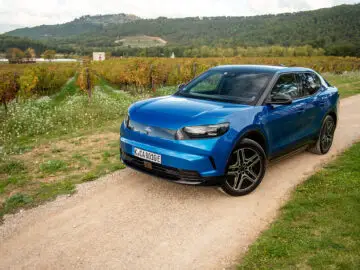

Still, we do see a bit of the Capri back, with long continuous lines from the nose to the window area. The roof seems to float, by the way, due to a black A-pillar. Slightly to the rear, the round C-pillar stands out, as a direct reference to the old Capri. The roof then slopes downward at an angle, unlike the related Explorer.
On the front and back, the name is written in full. So there’s no getting around that. The headlights are optically connected by a black bar, which we know as the “dogbone” of old. The slightly round lamps are literally nods to the once round headlights. At the rear, the lamps are optically connected by a similar black bar.
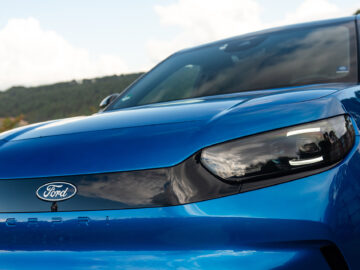
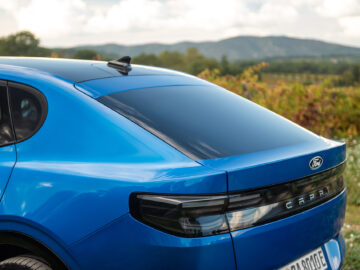
Great similarities
The Capri doesn’t just lean on its ancestor. The cooperation with Volkswagen allows Ford to buy heavily from the German brand. Among other things, the platforms of the ID.4 and ID.5 are used. Whether this benefits driving pleasure, you will read further on. In any case, it is an interesting aspect, considering Ford has a good reputation for handling.
Inside, the Capri is most like the Explorer EV. The dashboard is the same, with the recognizable raised Sync Move screen in the center, two-tone color scheme, sound bar and flattened steering wheel. The lower spoke of the steering wheel shows that you are in the Capri, with a metal trim and holes, just as the old one once had.

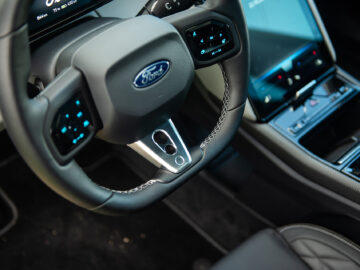
Tasty on the go
With a 15-inch size, a lot of information can be displayed on the Sync Move screen. Its low position makes it easy to operate. By the way, should you use the Capri’s own navigation, the car includes charging stops in plotting the route. Pre-conditioning the battery is also among the options.
As pleasant as the system works, it does mean that almost everything has to be controlled digitally. The climate control does have a fixed position at the bottom of the screen. You can adjust the volume with a physical slider, but it balances on the edge between ‘press’ and ‘touch’ and is not always very responsive. The same form of control is found on the steering wheel. Real buttons are more pleasant to use.
By the way, should the sun reflect irritatingly on the screen, you can tilt it up to 30 degrees. Under the screen you can store things in the Private Locker. In the center tunnel we find another large storage space of seventeen liters. Charging your phone can be done wirelessly or via two USB-C points.
In the front, it is otherwise very comfortable with standard seat heating, a massage function on the driver’s seat and also a heated steering wheel, with thus that retro spoke. Still, we see a bit of Volkswagen here, too. While the driver’s display has different graphics, it is directly copied, as are the window controls and the buttons for the lights. Not that we care, but these details make it lack just a bit of its own “Capri character.
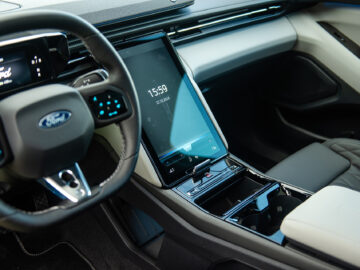

Extra space
In the back, the difference from the Explorer becomes obvious. At 4.67 meters long, the Capri is sixteen centimeters longer at the rear, and that benefits the luggage space. It starts at 572 liters, which is almost 100 more than in the Explorer. With the rear seats down, you have 1,400 liters of luggage space. By the way, the rear seats can only be folded down from the seats themselves.
The Capri’s roofline offers enough headroom for our tallest editorial board member (1.97 meters). On the other hand, especially if you are a little taller, your knees do come out a little high. A typical phenomenon for electric cars, because of the battery in the bottom. Otherwise, in the back seat we also find two USB-C charging points, ventilation and an armrest with cup holders.
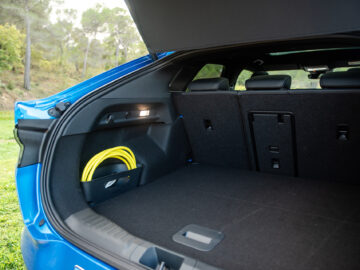
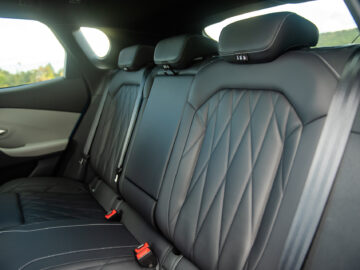
How does he drive?
At the base of this car is Volkswagen’s platform. That, of course, is a difficult starting point for Ford. The engineers had to focus on fine-tuning existing parts. For example, the ride height has been adjusted slightly compared to the Explorer (-10 mm). The result? The Capri is an EV that keeps up well. You shoot out of the starting blocks smoothly and you can feel what the car is doing in the corners as well, so a bit of dynamic driving is certainly possible. You have the choice of a light degree of regeneration and a slightly heavier one. The latter quickly creates a game of diving smoothly from one corner to the next without having to touch the brake pedal.
However, can its handling be called distinctive? Actually, the Capri drives like many other EVs and will not go down in the books as a real driver’s car. To turn a coupe-SUV into a nice steering car is of course a challenge. Perhaps Ford will someday come out with a sportier variant that offers a more distinct driving experience. That might even be possible on the inside. In sport mode, you have a slightly sharper response to the throttle and steering wheel, but other than that, all you see is an s-screen in front of you. Different graphics in a “Capri mode” and artificial engine sounds would perhaps do the fun content good.
Powertrains
In this case, we are driving the Standard Range AWD, the Capri’s top-of-the-line model with 250 kW (340 hp) of power and 679 Nm of torque. It has a 79 kWh battery pack that should allow you to go 592 kilometers (592 miles) according to the WLTP standard. Fast charging is possible up to 185 kW. Just “refueling” from 10% to 80% battery charge is peaked in 26 minutes.
In addition, Ford offers a Standard Range RWD and the Extended Range RWD. The former has a 52 kWh battery and an output of 125 kW (170 hp) and 310 Nm of torque. The range is not yet known, but assume roughly 400 kilometers. Fast charging is possible up to 115 kW. The Extended Range RWD boasts a 77 kWh battery and puts out 210 kW (286 hp) and 545 Nm of torque. Fast charging is possible up to 135 kW and the range is 627 kilometers under the most favorable conditions.
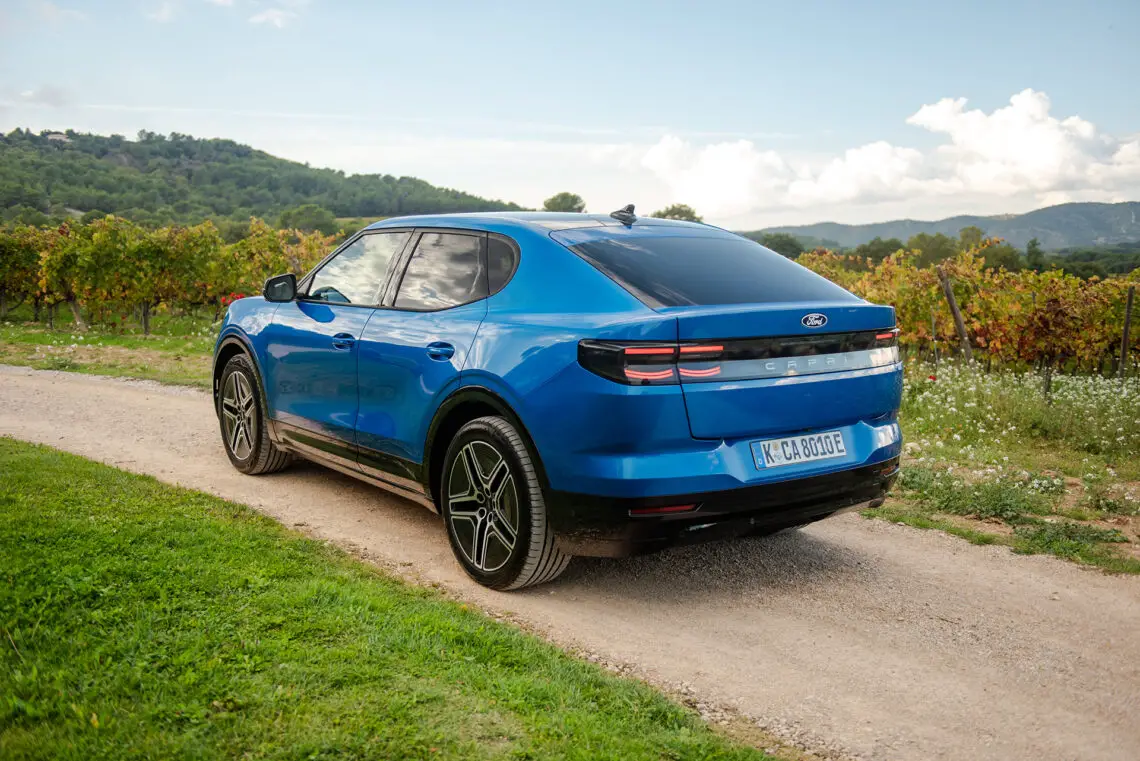
Prices and versions
The Ford Capri is slightly more expensive than the Explorer, with a base price of 43,350 euros versus 41,450 euros. Prices depend on the trim chosen. Ford offers three different powertrains and, in addition to the base model, the Capri Premium. In it, you benefit from a Bang & Olufsen sound system, ambient lighting, 20-inch rims (versus 19-inch as standard), matrix LED headlights and a power tailgate, among other features.
The Standard Range RWD starts at 43,350 euros. If you choose the Capri Premium in this, you will pay 47,350 euros. Those who opt for the Extended Range RWD pay 47,850 euros for the basic version, while the Premium variant costs 51,850 euros. For those who prefer all-wheel drive, there is the Extended Range AWD. This has a starting price of 55,850 euros and costs 59,850 euros as Premium.
Optionally, you can add a tow bar, giving you up to 1,200 kg of towing weight in AWD and 1,000 kg in RWD. The panoramic roof offers you extra headroom in addition to a pleasant amount of daylight and costs 1,100 euros. As standard, the Capri comes in the pronounced Vivid Yellow. The other five colors range in an additional cost from 500 to 1,200 euros.
As standard, the Capri features a variety of systems for comfort and safety. Think parking camera and sensors, blind spot sensor, heat pump for preconditioning and keyless entry. You also stay within the lines with Lane Keeping Assist and Lane Departure Warning, which can also be turned off in two clicks – sometimes that’s nice. Speed Alert is also standard and can be turned off.

Another car
Still, the driving experience makes you think. It really is a fine car for everyday use, but not the sportiness that its ancestor is. The design references on the outside are nice. The steering wheel spoke is also fine, but that’s where it ends. Couldn’t Ford have gotten much more out of this car?
The Capri builds on a classic, but seems to have left out the soul of the old Capri. This very thing could have given the car much more of its own character. A bit of retro design wouldn’t have been out of place either. Think of the new Renault 5, which looks distinctly like its ancestor. Ford could have made the Capri a little more eccentric. That may be the price Ford is paying for their collaboration with Volkswagen.
Conclusion
The new Ford Capri has a lot to live up to. Whether it really deserves the Capri name, opinions are divided on that. Leaving this aspect aside for a moment, we see a solid new EV for Ford. The Capri offers an acceptable range, plenty of practical space and very complete standard equipment. Despite the similarities with Volkswagen, what we have here is really a car with a different face.

